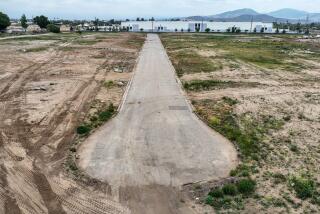Misled Plant Owner Still Has to Pay for Cleanup
- Share via
More than 30 years ago, Joseph A. Thomson bought a small Burbank industrial property for his growing business, assured by federal nuclear regulators that the site was free of radioactive contamination.
Officials now acknowledge that the property contains hazardous atomic waste left behind by previous occupants and that the government erred decades ago in certifying it as safe. They are demanding that the 85-year-old retiree pay millions of dollars in cleanup costs.
Federal regulators and state health officials say that the contamination most likely came from companies that made radioactive products on the land before Thomson bought it in 1966. A few years earlier, the U.S. Atomic Energy Commission had declared the site safe, believing that all hazardous materials had been properly removed, an AEC document shows.
But a recent federal reexamination of thousands of sites licensed to handle radioactive materials turned up problems beneath the onetime Fiber-Resin Corp. factory, where Thomson made aircraft parts for 26 years, as well as at 37 locations nationwide. Four sites are in California, including one that is now a Burbank bakery.
Thomson said that he has spent almost $1 million in legal bills and soil surveys, and that cleaning up the contamination could cost as much as $10 million.
After four years of jousting with regulators, Thomson said he knows only two things for sure. “It appears the contamination is a great deal worse than anyone thought, and neither the state nor the federal government has the money to do anything about it,” he said.
Thomson said he was forced to sell his 4,000-square-foot house in the quiet Glendale foothills, and move with his 83-year-old wife, Virginia, into a smaller, rented house under the noisy flight path for Burbank Airport.
“We didn’t have enough cash,” Thomson said, declining to elaborate on his personal finances.
“What’s that got to do with anything?” Virginia Thomson asked. “We don’t feel it is up to us to clean up the site. It’s just like having to clean the bathtub after someone else takes a bath.”
In an attempt to recover his costs, Thomson is suing the companies that acquired the now-defunct firms that were licensed to handle radioactive materials on the property. He also is suing the company hired decades ago to decontaminate the land.
Thomson also wants the U.S. Nuclear Regulatory Commission, the successor to the AEC, to take full responsibility for removing leftover contamination.
The Thomsons’ attorney, Malissa Hathaway McKeith, blamed the NRC for “sloppy decommissioning.”
Thomson said an AEC official had told him the site was safe shortly before he leased it in 1962. “They were saying, ‘It’s clean, it’s clean,’ ” Thomson said. Two weeks ago, Thomson obtained a letter dated Dec. 8, 1961, in which an AEC official certified that the site had been decontaminated and “may be leased or otherwise utilized.”
Today, Thomson’s 23,000-square-foot building is vacant and the fence leading onto the driveway is locked. No one is supposed to walk onto the contaminated property, the last commercial site before the area turns residential.
Although the land borders apartment buildings on one side, state health officials said it poses a health risk only to those who actually touch the contaminated soil.
McKeith asserts that federal regulators were negligent in failing to properly inspect the contents of a pool of hazardous materials buried 14 feet below ground.
Paul Goldberg, an NRC project manager, said his agency should not have released the Thomson property for unrestricted use without a more thorough review.
“I really feel sorry for people like that,” he said, but “property owners have the legal responsibility to clean it up.”
In the 1930s, Joseph Thomson drove from Connecticut to California to take a job with Lockheed Aircraft Corp. He quit in 1954 to start a business making aircraft parts. A few years later, he was looking for a bigger work space when the one-acre property at 170 W. Providencia Ave. was vacated.
“We were in business about two blocks away, but growing very fast, so I needed more people and more room. I had been watching this place, the one I unfortunately bought,” said Thomson, who at one time employed about 200 people in Burbank and a Detroit suburb.
Thomson leased the property for four years before buying it in 1966. He said he knew radioactive materials had been used on the site by previous tenants.
According to state documents, Isotopes Specialties Co. and Research Chemical Corp. jointly occupied the building in the 1950s and early 1960s. Isotopes Specialties manufactured radioactive isotopes used in X-ray and mining equipment while Research Chemical worked with rare-earth radioactive elements.
Closed Files Reexamined
In his own business, Thomson gained a national reputation over the next 30 years for formulating durable resins. One of his best-known formulas was used to make the popular Gumby dolls.
As Thomson began to think about retirement, Congress focused on the more than 31,000 properties where radioactive materials had been used by firms with AEC and NRC licenses that had since been terminated.
At Congress’ urging, the NRC began a vast reexamination of its closed files. Federal regulators targeted for inspection those properties, like Thomson’s, where the NRC lacked adequate documentation to show they had been closed properly.
“These were properties that should not have been released under the regulations of the time,” said Goldberg, who was in charge of the NRC review of closed sites for six years.
In 1988, Thomson sold his company to H.B. Fuller Co. of St. Paul, Minn., which leased the Providencia site from him for the next eight years at $12,000 a month. When Fuller moved out at the end of 1995, Thomson thought about selling the property, which he values at $1.5 million.
Coincidentally, that’s when his troubles began. Federal regulators and state health officials armed with Geiger counters visited Thomson’s now-vacant property in February 1996. Virginia Thomson described it as “the day all hell broke loose.”
From that inspection, Thomson’s property was identified by federal regulators as one of the 38 sites nationwide where radioactive contamination was discovered.
Another Burbank site, at 703 S. Main St., houses a commercial bakery, Viktor Bene’s Bakeries and Distribution Co., and is just six blocks from Thomson’s land. Like Thomson’s property, it had been occupied by Isotopes Specialties, NRC records show.
The 1996 report concluded that the residual radioactivity there “does not pose an immediate health hazard to workers or their products.”
Edgar D. Bailey, director of the state Department of Health Services’ Radiologic Health Branch, said last week that state officials believe the bakery is safe, and had the lowest levels of residual contamination of the California sites.
Ugo Mamolo, president of Viktor Bene’s Bakeries, said Friday that state health officials told him in 1996 that “everything was OK. They said if there was a problem, they would contact me. I never heard from them.”
Mamolo said state officials inspected his property for a second time Thursday, and again told an employee that everything was normal.
A 1996 NRC report on both Burbank properties concluded that they had elevated radiation levels “most likely due to previous AEC licensed activities conducted by Isotopes Specialties Co. during the 1950s and early 1960s.”
Another contaminated site is in Mojave, where two Nevada companies operated an experimental uranium mill in the 1950s, Bailey said.
The remote property poses little risk of exposure to people, he said.
The fourth California site, in San Ramon, was cleaned up in 1995 by the former licensee, Aerojet, the Sacramento-based aerospace and defense manufacturer, although it no longer operated on or owned the land, state and federal officials said.
Nationwide, 17 of the 38 contaminated sites have been cleaned up, Goldberg said.
Sharing Cleanup Responsibilities
But in California, cleanup has been delayed for years as federal regulators and state health officials bicker over jurisdiction. The NRC says California agreed in the 1960s to regulate nuclear sites. But California officials say the pact excludes sites previously cleared by the federal government.
Thomson says he should not have to pay for the cleanup, but he has few options. He cannot legally abandon his property or declare personal bankruptcy until his assets are spent, McKeith said.
Nor can Thomson sue the NRC for releasing the contaminated property for sale to him, the attorney said, because the federal government has immunity from such lawsuits.
“Congress said go out and look [for radioactive contamination],” McKeith said, “and did not say what to do [with it] when it’s found.”
To try to recover his costs, Thomson is suing Nucor Corp. of Charlotte, N.C., which acquired Research Chemical and Isotopes Specialties. Rhone-Poulenc Inc. of Collegeville, Pa., which subsequently acquired Research Chemical assets from Nucor, also has been named in the suit, McKeith said.
Also named as a defendant is ICN Pharmaceuticals Inc. of Costa Mesa, which bought U.S. Nuclear Corp., the firm Nucor hired to decontaminate the site in the early 1960s.
In an early ruling, U.S. District Court Judge Virginia A. Phillips said Thomson must at least share in the cleanup responsibilities because he knew radioactive materials had been used on the property and should have done more years ago to ensure the property was safe.
Attorney Christopher Bisgaard, who represents Nucor in the Thomson lawsuit, said if the land wasn’t cleaned up properly, it should be the responsibility of the company hired to do the work.
“Also the responsibility lies with the Thomsons. They purchased the property knowing there was some radiation contamination on it,” he said.
Cliff Saffron, senior vice president and deputy general counsel of ICN, said U.S. Nuclear cleaned up the Thomson land in accordance with government standards at the time.
Attorney James J. Dragna also denied that his client, Rhone-Poulenc, is liable for the contamination, saying it is not a successor to Research Chemical.
Thomson’s troubles worsened late last year, after he hired experts to survey the property.
At the time, he was planning to spend his own money to clean up the Providencia property, then try to collect his costs from Nucor and others, McKeith said. But that backfired when his experts found higher radiation levels than the government regulators had in 1996. The deeper they dug the more contamination they discovered, until they stopped without completing the survey.
Thomson reported the findings to state health officials, who then ordered the removal of radioactive soil from the property, citing “a hazard to the public health.” The ground has a radioactive contamination level that is twice the amount that has been found to increase cancer rates from prolonged exposure, the order said.
As Thomson prepares for a December trial, McKeith is scheduled to meet Wednesday with top NRC officials and staff members working for Rep. James Rogan (R-Glendale) to discuss the federal government’s potential role in the cleanup. She wants the NRC to clean up the property or force Nucor to pay to decontaminate Thomson’s property.
Now, in their golden years, the Thomsons are preoccupied with soil surveys and depositions, lawyers and government regulators. Their 60th wedding anniversary was spent with a mediator trying to resolve a legal dispute over the cleanup. On his 85th birthday, Thomson shared his cake with his attorney.
The couple had other plans for retirement. “I thought we would travel more,” Virginia Thomson said, “and visit our families and our grandchildren.”
More to Read
Inside the business of entertainment
The Wide Shot brings you news, analysis and insights on everything from streaming wars to production — and what it all means for the future.
You may occasionally receive promotional content from the Los Angeles Times.










